|
Do you want to be alerted when we update? Please
email micoverde@gmail.com
with "update alert" in your subject line.
Season Two: Pacific crossing logs
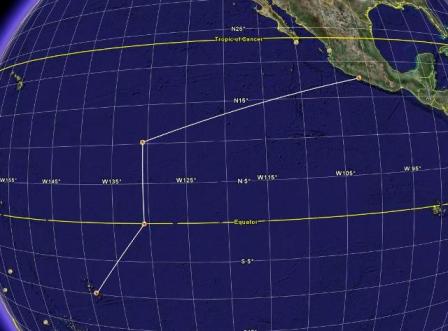
Warren’s sailing log for Zihuatanejo to Marquesas passage.
Day 0
4/13/05
Had a very emotional and wonderful sendoff in Z-Town. Jeanne dropped
by around 1345 to help us get the hook up off of Playa de la Ropa.
What a friendship we’ve enjoyed in our brief time together, I'm
really going to miss her in the south pacific. At 1415
we headed out of the bay and put out a final call on the VHF to all
our friends.
While getting the sails up near Roca Negra we promptly lost the jib
halyard up the mast (which surprisingly we’d never done before).
Steph was a mucho macho and retrieved it quickly in the bosun’s
chair while underway.
Had great sailing winds for the first 50 miles offshore (WNW 15 kts).
The winds continued mostly through the first night on passage but
started to die shortly after sunrise.
Day 1
4/14/05
This day was all about getting into the groove and trying out new
stuff. Due to the light winds we made an early heads’il change to
the new 170% genoa drifter which was acquired through Steph’s hard
efforts in Acapulco. We’d never actually bothered to find out if the
sail would fit before leaving so we hoisted it with great
anticipation but in the end she fit like a custom sail. A very nice
sail, seems quite new, light weight material doesn’t take much wind
to fill and very big. With some experimentation we quickly learned
that the best method for using the drifter in 5 knots, which we’ve
had all day and will continue to have for quite some time most
likely (according to Don Anderson), is to drop the stays’il and give
it as much wind access as possible.
While in Z-town we acquired lots of nice fishing tackle from the
co-op near the central pier. We’ve never done any fishing off Mico
before and were anxious to get started. We read up on a few ideas
for trolling in the Dashew Offshore Encyclopedia and went with one
long and one short fishing lines behind the boat. No strikes yet but
I think time is on our side in this passage.
Traffic has been fairly light so far, only a few freighters. Radio
reception for all nets and wx fax maps has been excellent.
Day 3
1600 UTC 4/16/05
The trip has already started to feel like an adventure in finding
new and exciting ways of breaking things everyday. When we lost of
electronic wind indicator to a short in PV last month at least we
knew that we still had our trusty “hawk” at the top of the mast.
About 120 nm out yesterday we encountered a swarm of pesky and very
tired boobies. One promptly landed at the top of the mast and bent
the hawk. We’ll try to go aloft to right it in the next calm. Last
night the clip holding the windvane feel out and we hove to. Today
while reaching we lost the stays’il topping lift up the mast after
the pin feel out of the shackle (gotta seize those suckas).
In happier news, we’ve finally found the NE winds. These are not yet
the trades but at 10 kts they’re keeping us headed downwind at
around 4.5 kts SOG.
Had very good luck getting weatherfaxes last night from Hawaii
station.
Day 4
1700 UTC 4/17/05
14 30’ N
106 12.9’ W
Wind 10 kts NW
Miles to go: 2447 nm
People who think offshore passage making is all about storm
avoidance couldn’t be more wrong in our experience! So far on this
trip we have had 5-7 kts of wind 70% of the time, > 10 kts 10% and <
2 kts the rest (when we’ve been motoring or just drifting around).
Light air this far out are really annoying because with the apparent
wind almost always less than 5 knots (heading downwind most of the
time) it means your sails are constantly banging, filling and
slating. Not good for them or the crew. I lay in my bunk at night
wondering when the main is going to get blown out for good. We have
some basic supplies for sail repair but putting a herringbone stitch
in a 10 foot rip at this point would be a major bummer.
I’m really thinking now that it would have been a good idea to lay
out the cash deposit for a new main as soon as we knew that we were
going to keep moving west. Even if we didn’t have it for the
crossing we’d have it for the next legs. I’m also looking at our
gooseneck a lot more suspiciously these days. It’s been fine so far
(touch wood) but the fact that all that’s holding the boom on is two
sheet metals screws doesn’t help me get anymore sleep at night. On
the next boat I’m getting a custom one fab’d and taking the design
straight from the Dashews.
Yesterday we thought we’d found some consistent winds at long last
when we picked up 15 kt NE’ers for most of the day but the very
light 5-10 NW’erlies have already returned (more banging sails).
We’re making 4.5 kts SOG but we’re headed far too north to be making
a good VMG. With this much wind and no reaching strut it’s
impossible to keep any air in the sails we sailing below 100 deg
apparent.
The weather has been getting a bit warmer and more humid with each
passing day. The sky has also changed from bright blue to a hazy,
near overcast. The nights are definitely the best for both of us. We
tend to have more winds, it’s not quite so hot and you can pass the
time for your off watch by sleeping. I have to say that the days out
here so far have been pretty long and tedious. Heads’il changes help
keep us going, though, and probably more fit as well. We’re
averaging two sail changes a day so far.
Have also been trying to muster the mental energy to get back into
celestial navigation. I have all the materials with me and a
starpath calc but somehow we managed to leave Seattle without any
nautical almanac or any sight reduction tables (the almanac part is
really ridiculous since before this year, when we went nowhere with
the boat, I bought one regularly). I have at least made it so far to
work out LAN for our current position, perhaps tomorrow I’ll drag
out the sextant to start taking sights.
Looking at the chart so far we seem to be averaging about 85 miles
made good so far – if we continue at this pace that will put us into
Hiva Oa sometime around the 7th of next month.
On amigo net this morning Don talked at length about the fact that
people getting started now for the passage to Marquesas shouldn’t
expect as good of weather as those who are almost there. He said
that local disturbances will soon start moving east to west N of 10
degrees.
Still haven’t caught any fish yet – although oddly enough last night
when pulling in the two lines before starting the engine we did
manage to catch a little bit of someone else’s line!
Day 6
1530 UTC 4/17/05
13 17’ N
108 12.9’ W
Wind 7 kts NE
Miles to go: 2559 nm
We’re still looking for the elusive trades, but we knew not to
expect them E of at least 115 degrees W so we’re not too surprised.
The wind has continued to be light but is now from the NE most of
the day. Occasional periods of 15 kt winds have occurred during the
midday and midnight.
Yesterday we treated ourselves to major bodily cleaning in the form
of sea water sluces (very refreshing) and a little fresh water rinse
via the sun shower. Being clean really makes all the difference in
one’s attitude.
The nights have been mostly enjoyable and quiet so far, watched
three episodes of Angel season five last night …
We’ve altered our course from 220 to 250 to keep us moving more west
than south in order to try to pick up some wind and avoid the ITCZ
which starts at around 08N and the doldrums which are currently at
around 10N.
Several boats are around 500-600 miles ahead of us including Laelia,
Sonrisa and the singlehander, Harry, or Rhiannon. Another boat,
Indria, is on our longitude but farther north about 160 nm from our
position. I’ll keep trying them on VHF as we get closer as they
might be able to relay our position on the nets for anyone who might
be interested.
Last night we had our closest call so far with having some fresh
fish aboard. I came up on deck at around 2100 local and found that
both lines had been tripped. The heavy line with 10’ leader and
seining twine was missing it’s lure and the other lighter 33 lb test
line was gone altogether! We’ve now rigged a proper alarm system
connected to the line consisting of some pennies inside of an empty
coke can.
Day 9
0412 UTC 4/22/05
12 16’ N
114 16’ W
Wind 17 kts N
Miles to go: 2256 nm
Days to go: 16
We’ve found some version of the trades although they don’t
officially start ‘til after 120 W. The past two days have brought
good daily runs in of 120 and 133 miles respectively.
Our fishing system finally paid dividends today! Talk about perfect
timing. Steph was on watch reading a book in the cockpit about an
hour before dinner time when she heard the clanging of the fish
alarm (some pennies inside a Coke can tied to the meat line). She
immediately called out to me down below “FISH ON!” As I hurried up
the companionway stairs she called out again “FISH ON the other line
too!” Our hearts were in our thoughts as we pulled in our quarry. We
grabbed two perfectly sized blue fin tuna. I’d never cleaned any
ocean fish before but it turns out to be a lot like cleaning lake
fish and the mess on the stbd rail wasn’t even that bad.
Blue fin makes incredible sashimi (raw fish) let me tell you. We
even had a little tube of wasabi squired away from months ago in the
pantry. It was the freshest thing I’ve ever tasted. In addition to
the sashimi Steph also broiled a couple of fillets and those were
amazing as well. Quite satisfying to sit in the cockpit of your boat
almost a thousand miles from land, eating a delicious fish you
caught not thirty minutes prior …
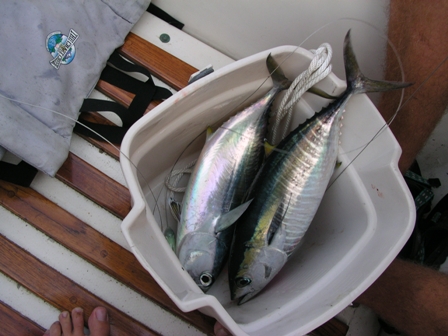
Our first catch of blue fin tuna
The boat has been sailing well but we’ve been getting lazy about
making sail changes the past couple of days. This has already
resulted in some unnecessary wear and tear on the ‘new’ drifter. In
the past days we’ve been using it ‘drift’ along at about seven
knots. The sail is definitely too light for these 20 knot winds,
it’s not a reaching sail and we’ll try to be more careful. Right now
we’re making about six knots with the working sails.
I’ve updated our course to take us a bit farther west and less of a
direct route to Hiva Oa. This was after getting excellent personal
weather routing today on 8A from Don. There’s quite a few other
boats with SSB around us at the moment and I piggy backed on sv
R-Factor’s routing question today. We’ll be starting the turn into
the ITCZ at 130 W and heading straight down the doldrums (180 T) to
cross them as quickly as possible to save fuel.
No squalls yet but I can definitely feel them lurking over the
horizon (especially as we get closer to the ITCZ). Last night I
spotted some dark rain clouds, got excited and promptly battened
down ever port light and hatch but it turned out to just be some
very brief light rain.
Day 10
0239 UTC 4/23/05
12 23 N
117 42 W
Wind 7 kts NE
Miles to go: 2058 nm
I think today was one of the best days I’ve had out here since
leaving Seattle last fall. It wasn’t due to screaming winds bringing
us closer to our destination (we only made 88 nms today in very
light winds, yesterday was our best run so far with 144) since the
trades were knocked out by a trough off Pacific Baja today. Don says
they’ll return tomorrow.
Today was like a Sunday morning or at the very least a day off from
the “work” of cruising across an ocean. Once we were able to trim
the sails last night sufficient to stop any slating and banging we
were making a very peaceful 3 knots over the ground but this was OK
by us. We awoke very refreshed and had a lazy morning complete with
some excellent eggs and coffee.
Things were even accomplished today. Steph repaired the damage
already done to the drifter (NOT for use in more than 20 knots of
wind, or 10 for that matter) and I finally figured out what the @#$%
was up with the wind vane (RTFM – I had the vane on backwards). It
only took me 4000 miles to figure out the thing, not bad for
cruising. As I type this the Cape Horn is steering the boat in fine
style with less than five knots of apparent wind.
We even managed to catch another tasty fish today – a nice 6-7 lb
blue fin tuna, just perfect for us both. It’s a blast to scream
“FISH ON” and have everything going on at that minute come to a
complete stop while we pull in our quarry. It was actually a bit
much and we pigged out on a sashimi starter followed by delicious
fillets. I think my fish cleaning is improving too. We’ve decided to
only keep one line out going forward because the tuna tend to hit
anything that moves and we’ll have too much meat. We definitely have
to find a better, more humane way of killing the fish once it’s on
board and freaking out. To date I’ve been using one of the bronze
winch handles to bash the fish to death but today’s entrée was a
serious fighter and took waaay more hits than I wanted to deliver (Steph
always makes me the heavy when it comes to this task) and the
cockpit was full of blood, even with the fish in the bucket, by the
end.
As part of our lazy day I spent most of the day thinking about
improvements to the “next” boat and generally annoying Steph with
details she could care less about. I’m keeping a file of everything
I’ve learned so far and would change in design, performance, comfort
etc.
We passed the 1000 nm mark today. We’ve only used about 12 gallons
of fuel so far, but I think we’re going to need every drop to get us
across the 300 nm stretch of the doldrums from 05-00N.
Day 13
2030 UTC 4/26/05
12 24 N
123 48 W
Wind 15-20 kts NE
Miles to go: 1600 nm
No more lazy Sunday afternoon sailing for us! We started our leg in
the ‘real’ trades (west of 120W) three days ago. Immediately the
seas doubled in size and the wind really picked up in the 25-30 kt
range. We’ve been making some very since daily runs with and average
in the mid 140’s with one in the 150’s – not too shabby for a 27’
waterline.
Last night we had our first run in with playing dodge ball with
squalls. We were able to do some shuffling and jibing to keep them
two miles off but I know we won’t keep ‘em all at bay.
Morale is getting a bit low at this point. We’re ready to cross the
equator and start making good toward Hiva Oa. Tomorrow should be our
half way point of the trip (I can’t believe we’ve already been out
at sea for two weeks). Our next let of the voyage will consist of
crossing the nasty convergence zone which starts around 09N down to
the doldrums. Then it’s light air/motor-sailing from around 05 to
01N to the SE trades. From there it should be a beam reach to
landfall.
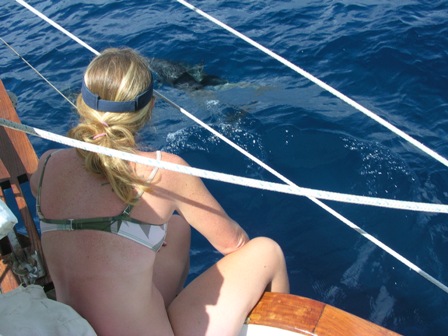
Supplies are OK at this point. We’ve only used about 12 gallons of
fuel for the last 1400 miles and we’re still on the first water
tank.
Day 14
0230 UTC 4/27/05
11 12 N
125 49 W
Wind 15-20 kts NE
Miles to go: 1400 nm
We celebrated two weeks at sea today by turning left at 125W towards
the equator.
Steph made an interesting and dubious discovery on her afternoon
watch. Four out of six of the wooden pads under the boomkim have
split – most of them completely and are threatening to fall out from
under the spars. Not good news. The boomkin is what the aft stay
(biggest/longest on the boat) is attached to so we’d definitely not
want that to fail. I should have noted earlier that these pads
needed replacing since they’re obviously very old and were never
even treated with epoxy, resistol or painted etc. We’ve served the
bad pads with tarred marlin up tight to at least try to hold them in
place under the spars ‘til we make landfall and can replace the lot
of them. If the pads fall out completely we’re going to have and
interesting time of trying to make news ones and pull the old
carriage bolts at sea.
One can’t believe all the loads a boat takes on a long passage like
this one. With the constant 25 knot winds, 10 foot seas and rolling
things definitely start to wear down and move around a lot. The seas
last night we’re the worst so far (which may have been the point
were the pads cracked). We were getting pounded by 15 footers
breaking over the decks beam on.
The worst part of finding something like this is that we weren’t
even looking for it – tomorrow is thorough rig check day …
Day 16
1950 UTC 4/29/05
07 37’ N
127 06’ W
Wind 15 kts NE
Miles to go: 1350 nm
We are still having good luck (touch wood) with the trades, even
down here at 7N. I picked up the latest tropical synopsis last night
from Pt Reyes and it looks like we’ll hit the ITCZ officially at
around 05 30’ N.
I think I’ve discovered the cause of the boomkin issue from the past
couple days. When we installed new rigging fore and aft I don’t
think I set the rake of the mast far enough aft. I never used an
imperical method, e.g. a plumb bob, to get it exactly 6’’ aft as
should have been the case. If we ever have a calm day I’ll slacken
the forestays and try to bring the mast aft a bit to sit on the
broken pads more evenly.
Squalls have been a lot more consistent these days as we head south.
No major blasts so far (25 to 30 knots during the downdraft) but
they definitely keep you occupied while on night watch. The rain
always feels great though and the boat badly needed a rinse.
We caught our first dorado last night but since we’d already eaten
and it was only about 12’’ long we put it back.
Have I talked much about the wind vane on this passage yet? It’s
been totally indispensable and we’ve used it for 90% of the steering
so far. It does pretty well considering that it’s still out of
alignment which prevents it from steering as well to stbd as it
could. The most reassuring aspect about the vane is that the faster
you go and the more wind it handles the stronger the steering
becomes. It’s also much easier on our electrical usage (which is
always an issue since it’s overcast nearly every day in the trades).
Day 17
2017 UTC 4/30/05
06 18’ N
127 54’ W
Wind 5 kts SE
Miles to Hiva Oa: 1163 nm
I can’t believe that it’s almost May and that I was in Spain this
time last year.
The trades are finally caput and left us promptly last night at
around 06 55’ N. We can’t complain though since we were on borrowed
time since we crossed S of 08N. The winds are now blowing very light
from the SE (I hope they gradually start to get stronger as we head
south since we definitely don’t have an unlimited supply of fuel).
The squalls just kept coming in lines yesterday and last night, ugh,
what a pain they are! Non too serious yet, presumably since they
were forming in a min of 15 to 20 knots of wind, which I didn’t
think could happen. Of course when we did have a decent one in the
30 kt range we started having major issues with our reefing system.
Apparently after sailing for thousands of miles downwind in mostly
NW winds down the coast of the US and Mexico we’ve very rarely ever
had to put a reef in when on port tack. On this tack everything is
quite a mess since all the sail material is in the way of the slab
reefing lines. Last night I even managed to tear (repaired by Steph
this morning) the main in two places when putting in a second reef
due to the sail cloth getting pulled into the reefing block. Moving
the reefing blocks on the boom seems to have solved this issue but
we still have issues with the #1 reefing line chafing (and breaking
as happened yesterday too) as the block on the dead-end side of the
boom was incorrectly installed (the first and only rule of rigging
is “fair leads” – Brion Toss).
The weather has been very hot but pleasant today and the seas are
very moderate. With a break from the 25 kt, 10 ft seas of the past
couple of weeks the first thing we did today was to take nice fresh
water showers and change the sheets on our bunks.
I tried to do some fuel consumption math based on our previous log
entries this year at around 1500 RPMs. I think we’re burning around
0.77 gallons per hour at this rate which gives us enough fuel for
about another 350 miles or so. Glad we resisted the temptation to
motor in some of those brief light spots at the beginning of the
trip.
If ever planning for this trip it’s good to know that for San Diego
or Mexico to the Marquises you really only need one chart for the
whole thing (actually there’s only one available) – DMA INT 51. Not
knowing this I purchased an entire “Pacific crossing package” from
Tide’s End in Bellingham at great expense (in addition to the south
Pacific charts and an invaluable tides guide from NOAA).
Since things have settled down a little I’ve been trying to be more
thorough about checking things out around the boat. On a whole
things are holding together pretty well but what a ton of stress a
trip like this puts on every boat system. I’ve definitely been very
preoccupied everyday thinking about all of these in one way or
another since we’ve left and it’s cost me much book reading and
sleeping time.
Day 18
2100 UTC 5/1/05
05N 128 W
Wind 10 kts E
Miles to Hiva Oa: 1100 nm
We’re still wallowing in the doldrums and now we’re officially in
the ITCZ. Trying to save fuel has been a challenge but our patience
paid off in the end today and we’re currently beam reaching at
around 155 true heading toward the equator. Quite a bit of fuel was
burned yesterday to put us only about one degree of latitude closer
to getting out of the doldrums. I’ve started getting WX faxes out of
Honolulu at select times of the day but Pt Reyes is still my ol’
reliable for the tropical surface analysis.
In the calm and relatively cool morning today we set to work in
earnest to address the problem of not having enough rake in the
mast. All sails we’re removed, forestay slackened completely and
jibstay slacked nearly to 2% or so. The aftstay was tightened and
the mast came back a little. I also decided to be a bit more light
with bending the mast as well as tuning to a breaking strength of
12% (we were previously using 15% on the jibstay and 20% on the
aftstay). To complete the process I need to work on the lowers,
however, as they play a part in the bend and rake to a degree as
well (bringing the mast back slackens the aft lower and tightens the
forward one accordingly). I’m probably doing something not quite
right but I can’t seem to find a way to put the mast in a truly
neutral, non-bendy state although I know it’s beneficial to at least
take the “spring” out of it with a little bend of no more than a
mast width etc. While on the subject of rigging I can with great
certainty state that at the first opportunity I’m going to rig a
topping lift for the boom, which would make reefing the sail so much
more convenient.
Working with the lower shrouds will be a complete joy compared to
the fore and aft stays since doing so involves hanging over the
water in pitching seas and always gives me some vertigo.
I was just thinking about the concept of VMG (velocity made good) in
terms of sailing and it’s relationship to the horribly limiting
notion that “the shortest distance between two points is a straight
line.” As opposed to a boat’s speed “in-the-water” (the rate the
boat is traveling through the water) or a boat’s SOG (the rate the
boat is moving relative the earth/bottom), VMG is a specific
measurement of velocity that applies specifically toward some point
on the earth. This can be a point of lat/lon, a buoy, a windward
race marker etc. Because of the former most racing sailors are
extremely familiar with this concept but to cruising sailors like me
it took some getting used to.
To illustrate how we use VMG more than SOG everyday out here imagine
you have a waypoint set in your GPS at 00 N 130 W, right on the
equator. Assume you start out at 05 N 130 W and you want to run
straight down the meridian because you’re getting really sick of
light, fluky winds and after your fortieth squall you’ve learned you
weather lesson by now pretty well (wind blast, downpour, veer and
light winds, rinse and repeat). If the winds are out of the SSE you
might be tempted to try and pinch up and head straight for the
waypoint at say 2.5 knots, since you’re headed right for it your VMG
is the same. However, if you crack off the wind a bit and put the
boat on something closer to a beam reach, which is the fastest point
of sail on many boats you start making about 4 knots and your VMG is
now around 3 knots.
What does this mean? You’re actually making better progress toward
your goal by not sailing straight for it. So one can definitely see
that the “shortest distance” analogy is wholly dependant on the R in
D = RT being constant. I think it’s probably also very dependant on
the T being consistent as well which gets very confused in quantum
mechanic/string-theory stuff. Also, from a practical standpoint
unless you’re rounding a mark or shooting a reef pass you don’t
necessary have to pass right through some point in space but rather
a line (like the entrance to a harbor or the equator) so you have
room to figure out the fastest way to get across that line instead
of thinking just about the point.
Watched two episodes of Angel season five last night. Man, I can’t
believe they actually killed off Cordelia (what an episode)! I also
can’t believe the stupid WWII episode which made no mention of any
of the previous events that followed.
Day 21
1730 UTC 5/4/05
01 30’ N 129 45’ W
Wind 20 kts SE
Miles to Hiva Oa: 863 nm
We’ve finally made it out of the ITCZ and it lived up to all of it’s
notorious legend. What an absolutely miserable place! Constant rain,
thunderstorms, lightning and violent squalls day and night. The
first night we lost the autopilot to a major downpour and had enough
wind that the shackle pin on the end of the mainsheet broke at the
boom (nice to know that this was the weak link in the chain as
opposed to the gooseneck).
Week four has just begun and we’re beating hard into the SE trades
on the rhumbline course to Hiva Oa. So much for listening to the
experts. If I made this trip again I wouldn’t wait ‘til 128 or 130
to jibe into the smaller ITCZ but would instead suffer an extra day
of it to be able to beam reach into the Marquises. All night we were
pounding into heavy seas and I can just feel every bolt onboard
working its way loose.
Day 22
2330 UTC 5/5/05
00 28’ S 130 45’ W
Wind 10 kts SE
Miles to Hiva Oa: 730 nm
So maybe the experts aren’t so dumb. It turns out that there was
just a lot of S in the previous SE’lies. After our fast beat over
the past couple of days the wind has been getting a bit lighter and
backed enough that we’re now reaching.
We crossed the equator at around 1000 this morning and celebrated
the occasion with a nice cake a la Steph. The boat was so very
peaceful last night that we both had the best sleep/rest we’ve had
in weeks. The sky is now bright blue again with no sign of trade
wind clouds, just some wispy altostratus and it’s comfortably warm.
The sun is super intense however and after various burns to nether
regions we both keep inside the cabin as much as possible.
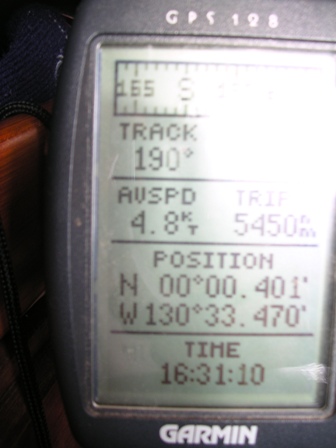
The stars were extremely bright last night and the sky looked so
foreign. I can’t believe that a boat that simply sat around a cold
marina in Seattle for the better part of a year is now sailing the
waters of the south pacific …
Finished Angel season five – good season, sad to see it all come to
an end. Can you believe there are no more active Joss Weadon TV
shows in production? Maybe they’ll bring back Firefly after the
movie comes out.
Day 26
2230 UTC 5/9/05
06 13’ S 135 21’ W
Wind 10 kts SE
Miles to Hiva Oa: 292 nm
We encountered very brief trade wind conditions yesterday and made a
great day’s run. If it held I think we would have been on par for
some kind of a Westsail record (the best one I know about was from
the winner of the pacific sea cup at 178 nm).
Two nights ago we caught a beautiful 8 lb mahi mahi which was a
perfect size for the two of us and lead to excellent sashimi and
fillets.

Nice mahi-mahi is a morale booster
Morale is getting pretty low and I think it will get very bad when
Steph finishes off the rest of the books. The talk of the “next
boat” which was so readily available at the beginning of the trip
has come to an abrupt stop. Topics now have shifted more to “how the
hell are we ever going to get this boat home.”
I wonder what our first port of call will hold in store for us? Will
the natives and gendarme be friendly? I hope it’s not asking too
much that we get some props and not be treated like tourists.
There’s a big difference in spending a month at sea on a tiny little
boat and jumping on a flight from LAX for nine hours.
Touch wood, the boat continues to hold up and sail well. I did
manage to bend to rigid vang the other day while putting in the
second reef in big swells.
Although the winds have been light we’ve been toughing it out and
not motoring more than an hour here and there to charge the
batteries. We’ve used half our fuel in the tanks at this point (35
gallons and we have 10 in reserve too). We’ve used up the jerry jugs
of fresh water (we could have filled ‘em both during all the squalls
be were too lazy and exhausted) and we’re still on the first water
tank.
The autopilot has come back from the dead somewhat but steers
erratically and probably needs to be calibrated. The wind vane has
been absolutely crucial to our sanity on this trip. And to think
we’d only used it for about an hour total before having it steer for
3,000 miles!
Day 28
2225 UTC 5/11/05
08 42’ S 137 33’ W
Wind 15 kts SE
Miles to Hiva Oa: 97 nm
Four weeks at sea … I can’t believe we’re in the double digits to
landfall.

Making our French courtesy flag right before
arrival
Even though we’ve been navigating 98% on the time (with only very
infrequent sun sights with a running fix) I can’t help but wonder if
the islands will be where we think they will be. I looked at the
date of the French chart I’m using and it’s from an expedition in
1880. There’s very large notation that states “the position of the
islands is not to be relied upon.” We’ll see.
Mico is really smelling the barn today and making a steady 5.5 kts
in light aris with just the yankee and stays’il heads’ils and a reef
in the main to balance (low aspect cutter rig).
We must be getting close because Steph treated the crew to a big
breakfast of fresh rolls, potatoes and strong coffee. She even
finished the construction of our French tri-color courtesy flag.
Day 29
5/12/05
09 48.1’ S 139 01.9’ W
Wind 5 kts SE
Miles to Hiva Oa: 0.00 nm
LAAAAND HOOOOO!!!
This morning we finally caught sight of the eastern most cape of
Hiva Oa (it was actually were we’d expected). We were promptly
radioed by the first boat to see us rounding the point and welcomed
to Polynesia after a very long passage.
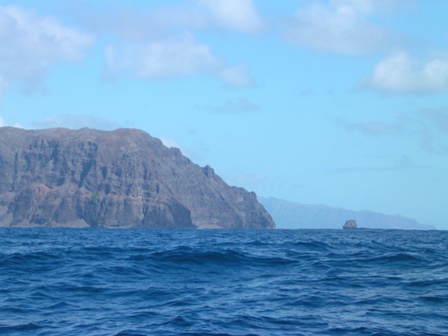
Cape Matafuena and motu tapu
Mico is finally lying in repose in Taaoa Bay (Traitor’s Bay) in the
southern coast of Hiva Oa. I can’t believe we’re actually here and
not still out at sea. Our route turned out to be just over 3200
nautical miles total. The wind was very light today and we had to
use the engine to cruise down to this side of the island.
Hiva Oa is such a beautiful place and so unlike anywhere we’ve even
been before. After setting the hook in the very crowded anchorage
(we have about fifty feet between us and boats on three sides of us
and lava rocks within 50 on the other side) we were obliged to not
do anything at all and just relax a bit on our messy boat. As soon
as we arrived the neighbors dropped by to help us set our stern
anchor and even brought us a couple of celebratory ice cold beers
(thanks Joe).
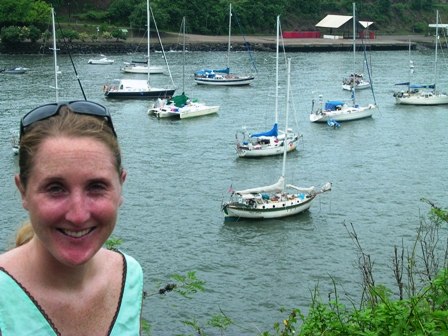
Steph with the crossing fleet in Atuona
Footnote: The next day we set to work in earnest putting the boat in
order and surveying the damage. The foredeck was a mottled pile of
canvas (three big sails) but we finally developed a really good
system for flaking the sails and they’re now all happily bagged. We
also made our first foray into the local village of Atuona which is
the most well manicured place I’ve ever seen. Everything’s so simple
but very elegant and not a scrap of trash anywhere! The locals have
been very friendly but we quickly learned just learned just how
rusty our French has become after all these years (later in the
evening we spent the better part of the night quizzing each other on
the most common verb conjugations).
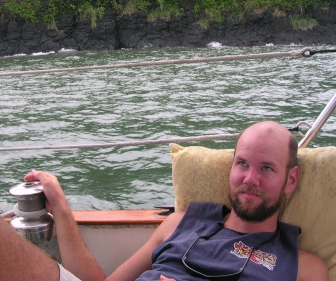
The old man, hella glad to be done with the long passage
in Atuona (Steph: I like to call this
look "Christian campfire guitarist")
To read previous posts, check
out the Journal!
|










